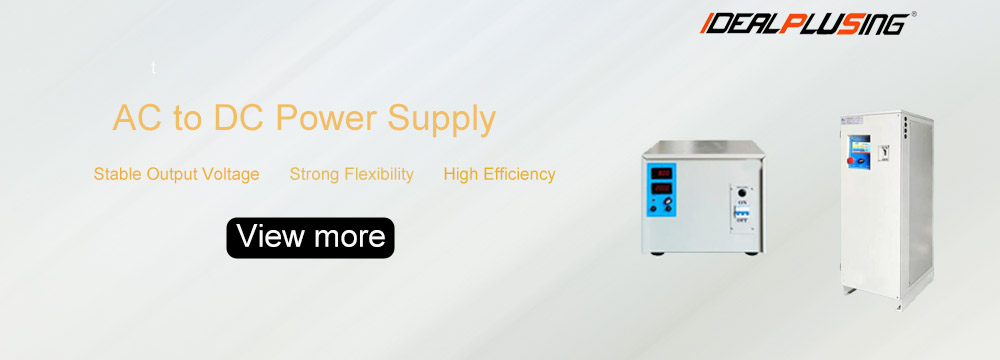Electroplating is an electrolytic process. It goes without saying that factors such as the performance, type, and characteristics of the power supply will have a significant impact on the electroplating process. Especially in today's rapidly developing electroplating technology, electroplating power supplies play an even more crucial role. Therefore, understanding the impact of electroplating power supplies on the electroplating process is essential. This article introduces some experiences and lessons learned from the application of electroplating power supplies and low-ripple rectifier power supplies in the electroplating industry.
1 Basic Principles and Types of Rectifiers
1.1 Traditional Silicon Rectifiers
Silicon rectifiers have a long history of use and mature technology, and are currently the mainstream rectifier product.
1.1.1 Rectifier Circuit. In industrial production, conventional silicon rectifiers are generally used, with a three-phase voltage regulator for voltage regulation and a 50Hz three-phase power frequency transformer for voltage reduction. All rectifier circuits generate pulsating DC power, not pure DC, and contain varying degrees of AC components. To compare the amount of ripple, the ripple factor can be used to represent it. This refers to the percentage of AC to DC. The smaller the value, the less AC, and the closer it is to pure DC.
Different rectifier circuits have different ripple factors. Their order, from largest to smallest, is: three-phase half-wave rectification, three-phase full-wave bridge rectification, or six-phase double-reverse star rectification with balancing reactors. The latter, with the rectifier elements conducting in parallel, produces the smoothest waveform, higher rectification efficiency, and more reliable operation, making it the most commonly used.
To achieve low-ripple output, filtering or other special measures must be employed. Filtering using capacitors and inductors is a common method for converting pulsating DC to smoother DC. However, in actual production, filtering is rarely used in industrial production, except for small rectifiers used for testing. Large inductors may be used in special circumstances. Capacitors are not suitable for filtering at low voltages and high currents. Capacitor filtering is only suitable for very low-power rectifier power supplies for power frequency rectification. For example, to achieve low ripple output, a single-phase full-wave rectifier with a 10A output requires a filter capacitor of at least 0.1F. As the frequency increases, the required capacitance decreases.
Ordinary thyristors, which adjust the average DC output by varying the conduction angle of the thyristor, output discontinuous pulses. Their ripple factor is controlled by the conduction angle, resulting in a higher ripple factor than that of ordinary silicon rectifier circuits. This is especially true when the operating current is significantly lower than the rated current.
1.1.2. Rectifier Element Types
The rectifier element is commonly known as a diode. Since all the output current of the rectifier passes through the rectifier, it can be said to be the heart of the rectifier. Rectifier elements are divided into two types: silicon rectifiers and thyristor rectifiers. Chrome plating rectifiers primarily use silicon rectifiers. Although thyristor technology has made significant progress and its application in electroplating is increasing, I still recommend using silicon rectifiers. The main reason for this is the waveform. Thyristor rectifiers control current by varying the on and off times of the rectifier element. The waveform is good when the rectifier is operating at full load, but deteriorates at low output currents. The lower the current, the worse the waveform. In contrast, the output current of a silicon rectifier has almost no effect on the waveform.
1.2 Switching Power Supply
A new type of electroplating power supply is currently available: a high-frequency switching power supply. It combines the waveform smoothness of silicon rectifiers with the voltage regulation convenience of thyristors. It offers the highest current efficiency (over 90%) and the smallest size, making it a promising rectifier. Current manufacturing technology has solved the power issue, and high-power switching power supplies ranging from thousands to tens of thousands of amperes have entered practical production.
Switching power supplies have reached audio frequencies, making it easier to achieve low-ripple output through filtering. Furthermore, current and voltage stabilization functions are more readily implemented.
1.3 Pulse Power Supply Equipment
With the advancement of power electronics technology, electroplating rectifiers are evolving from single-function to multi-function. Because pulse power supplies are primarily controlled by embedded single-chip computers, they generally possess a variety of control functions in addition to pulse output.
1.3.1. Automatic Current and Voltage Stabilization. Traditional silicon rectifiers' current or voltage cannot automatically stabilize and fluctuate with grid voltage fluctuations. Pulse power supplies, however, possess highly precise automatic regulation capabilities. For example, when the three-phase grid voltage fluctuates by hundreds of volts, the output voltage of a pulse power supply can remain virtually unchanged. Pulse power supplies generally have two automatic regulation modes:
① Constant current and voltage limiting mode. When electroplating process parameters, such as part area, temperature, concentration, and pH, change, the current of a conventional rectifier will fluctuate. In constant current mode, the output current automatically remains constant at the set value. This is particularly useful for accurately calculating hard chrome thickness. The voltage limiting function in constant current mode protects the equipment from burnout.
② Constant voltage and current limiting mode. When electroplating process parameters change, the output voltage automatically remains constant at the set value. This mode is not commonly used in hard chrome plating, but it is very useful for aluminum anodizing and coloring.
1.3.2 Multi-stage Operation Mode. Aluminum anodizing or hard chrome plating often requires reverse electrolysis, high-current surges, and stepped power supply operations. Traditional power supplies can only perform these operations manually. However, pulse power supplies with multi-stage operation modes only require pre-settings and can automatically adjust the sequence during production. This feature is very useful for hard chrome plating. Currently, domestic pulse power supplies have achieved three-stage operation, with each time period adjustable from 0 to 255 seconds.
1.3.3 Bidirectional Pulse Function. The positive and negative pulse frequency, duty cycle, and forward and reverse output time can all be adjusted independently, providing flexibility and convenience. Combined with the hard chrome plating process, coatings with different physical properties can be obtained.
1.3.4 DC Superposition Function. While outputting positive and reverse pulse currents, the same power supply also outputs a pure DC component, further expanding the application range and applications of pulse power supplies.
In recent years, domestic multifunctional pulse power supply technology has matured, with performance indicators such as pulse waveform verticality, waveform smoothness, stability, and anti-interference performance reaching or even exceeding international standards.
DC power supply waveforms have a significant impact on electroplating quality. For example, high-frequency, constant-pulse-width, high-frequency, regulated voltage/current pulse power supplies produce unique effects during electroplating that cannot be achieved with conventional DC power supplies, and some phenomena cannot be explained by conventional electrochemical theory. The impact of DC waveforms on electroplated deposition is currently difficult to predict theoretically; only extensive testing and comparative analysis can be conducted to identify the appropriate waveform.
2 The Impact of Electroplating Power Supplies on the Electroplating Process
2.1 Chromium Plating
Among various electroplating processes, chromium plating is one of the most affected by power supply waveforms. While many agree that chromium plating requires a low-ripple DC power supply, otherwise the gloss range will be narrow and the coating will be prone to fading and graying. However, in practice, insufficient understanding persists, often leading to problems with chromium plating quality due to excessive ripple coefficients. Therefore, the choice of electroplating power supply is even more crucial.
For hard chrome plating, which frequently uses reverse electrolysis, a power supply polarity reversing device is required. A simple method is to use a manual reversing switch. However, due to the high current, large sparks are generated when the switch is turned on and off, which can easily damage the switch. Immersing the contacts in transformer oil can extend the service life. Silicon-controlled rectifiers are relatively easy to commutate, as they operate contactlessly and avoid spark erosion. If the current fluctuation is small, a thyristor polarity reversing device can be considered.
The power supply waveform has a significant impact on chrome plating and is often overlooked by the operator. For example, a factory was plating decorative chrome on small parts, but the coverage was very poor. Repeated adjustments to the ratio of sulfuric acid to chromic anhydride in the plating bath were ineffective. On-site inspection revealed that the output ripple factor of the old 1000A thyristor rectifier, which had an average current of only around 200A and a very low load factor, was clearly too high. Switching to a silicon rectifier with a double reverse star output, restored normal chrome plating. Another chrome plating plant was operating normally in the morning, but in the afternoon, the decorative chrome began to discolor in patches, halting production. Suspecting a plating bath malfunction, repeated additions of sulfuric acid and barium carbonate for a day or two failed to resolve the issue. Analysis revealed no sudden change in the bath's composition, but suspected damage to the silicon rectifier tubes, causing waveform distortion and increased ripple. Using a clamp-on ammeter to measure the current in each tube revealed two open circuits. Replacing the tubes resolved the issue.
When plating micro-cracked hard chrome, excessive output ripple can result in cracks that are less dense and unevenly distributed.
Using pulsed chromium plating can also produce excellent coatings. Research has shown that using process conditions of 1000Hz frequency, 1/5 duty cycle on:off, 40A/dm² average current density, and 30°C temperature, the resulting chrome coating exhibits a threefold increase in wear resistance and a fivefold increase in corrosion resistance.
2.2 Bright Acid Copper Plating
Generally, bright copper plating follows a common pattern: as observed on Hull cell test pieces, the higher the cathode current density, the better the coating's brightness and leveling; the lower the current density, the worse the brightness and leveling. Expanding the brightness range in low current density areas has always been a constant goal for electroplaters. This requires addressing multiple aspects, including brighteners, process formulas and conditions, and equipment. Bright acid copper plating is one of the most consistently bright and leveling coatings to date. However, in practice, using the same formula, process conditions, and brightener can result in significant variations in brightness, leveling, and brightness range. This is largely due to the output ripple factor of the DC power supply used. This pattern was confirmed over 20 years ago during the development of the MN series of bright acid copper plating additives in China. The pattern is: the smaller the output ripple factor, the better the coating's brightness and leveling, and the wider the current density range. Furthermore, the smaller the ripple, the lower the amount of brightener required. Unfortunately, this issue has yet to gain significant attention among electroplating technicians.
2.3 Semi-Bright and Bright Nickel Plating
Generally speaking, bright nickel plating does not require the same high rectifier output ripple coefficient as chrome plating and bright acid copper plating. However, it does require a standard low-ripple DC power supply to ensure the quality of the bright nickel plating layer and the subsequent chrome plating. For example, a factory used a voltage regulator-type six-phase double-reverse star-type silicon rectifier with a balancing reactor, which had consistently good quality. Later, they switched to a standard 12V thyristor rectifier. While the performance was acceptable at high currents, it was far from ideal at low currents, with the plating exhibiting passivation phenomena such as blooming and graying. Using an 18V standard thyristor power supply further degraded the performance, leading to frequent quality issues during subsequent chrome plating. It should be noted that the chrome plating power supply was not defective. Initially, we investigated the nickel plating solution and brightener, conducting experiments to no avail. Finally, we determined the power supply was the cause. Switching to a switching power supply with a lower ripple factor immediately resolved the issue, resulting in consistently excellent results. Subsequent chrome plating has also avoided similar quality issues.
Research has shown that using pulsed power for nickel plating can also improve the porosity, ductility, and hardness of the deposited layer, reduce internal stress, and enhance the dispersibility of the plating solution. Bright deposits can be achieved without brightener, or with only 1/100th the amount of brightener used in DC plating. The metal deposits also reach nanocrystalline size. Therefore, with nickel prices currently rising and pulse rectifier prices falling, it's important to consider pulse plating.
2.4 Sulfate Acid Tin Plating
Sulfate bright acid tin plating is inherently challenging to achieve. This is due to the ease of impurities introduced and difficult to handle during large-scale production (including tetravalent tin ions), the narrow temperature range, the suboptimal brighteners currently available, and the vastly fewer intermediates available than for bright nickel plating. Consequently, widening the coating brightness range is difficult. Another lesser-known issue is that this process also requires a low-ripple DC power supply, otherwise similar problems as with bright acid copper plating can occur. Failure to prioritize the selection of electroplating rectifier power supplies can sometimes exacerbate the problem.
A foreign company has conducted research on pulse tin plating without brighteners and found that using a waveform with a duty cycle of 25%-30% and a frequency of 1000-10000Hz can produce sub-nanocrystalline coating crystals. These crystals are crucial for improving coating properties such as thermal corrosion resistance and wettability with molten tin.
2.5 Electrophoretic coating If the DC ripple coefficient is large during electrophoretic coating, the porosity of the coating will increase, the bonding strength between the coating and the substrate will also decrease, and the salt spray test will not be easy to pass. Therefore, this process also requires the use of a low ripple coefficient DC power supply. Due to the particularity of electrophoretic coating, there are some special requirements for the current power supply. For example: (1) The whole machine should have a soft start function; (2) The power supply should have a timed automatic shutdown alarm function. This is because the tank voltage has exceeded the human safety voltage, so it is easy to cause electric shock accidents during manual operation. 2.6 Precious metal electroplating Pulse electroplating has been successfully applied to precious metals for a long time. It is still widely used in precious metal industrial production. The reason for its success is that the scale of precious metal electroplating is generally small, and pulse power supply equipment has been solved. However, ordinary heavy metal electroplating and high-power pulse power supply equipment are difficult to promote in terms of manufacturing and price. 2.7 Alloy and Composite Electroplating
The challenges of alloy electrodeposition are: first, maintaining no significant fluctuations in the alloy composition ratio in the coating; second, maintaining a consistent alloy composition ratio over a wide current density range. Using a low-ripple DC power supply can improve coating quality.
Similarly, pulse plating can also produce high-quality coatings. Pulse plating has been extensively studied for copper-tin, cobalt-nickel, and nickel-tungsten processes. However, its application is currently limited.
2.8 Aluminum Oxidation
Pulse oxidation offers significant advantages over conventional DC oxidation. It significantly improves the hardness, thickness, and speed of the oxide film. It has been widely used in military and other applications.
3 Other Issues to Consider
3.1 Plating Bath Temperature Rise
DC power supplies with high ripple coefficients and pulse power supplies tend to accelerate temperature rise. Theoretically, this is because any non-pure DC or sine wave can be decomposed into pure DC and primary, secondary, tertiary, and higher harmonics. The larger the ripple coefficient, the greater the harmonic components. Generally speaking, AC harmonics do not contribute to DC electrodeposition, but they can generate significant ohmic heat, accelerating the temperature rise of the plating bath. Therefore, using a constant-pulse-width, high-frequency, voltage- and current-regulated pulse power supply and a low-ripple DC power supply can help reduce the temperature rise of the plating bath. One of the most troublesome issues with chloride and zincate zinc plating in summer is the rapid temperature rise of the plating bath (especially in barrel plating), which increases additive consumption and deteriorates the performance of the plating bath and the coating. Using smooth DC helps keep the plating bath temperature low.
3.2 Effect of Rectifier Loading Rate on Ripple Factor
The closer the operating current is to the rated current of the rectifier, the smoother the waveform. This is particularly true for thyristor rectifiers. When selecting a rectifier, based on process requirements, choose a rated output voltage close to the maximum required value to avoid the "big horse pulling a small cart" phenomenon during operation and ensure that the output ripple factor of the rectifier power supply remains low.
The rectifier power supply may operate in a phase-short circuit due to a damaged rectifier tube. For three-phase electroplating power supply, even if one phase fails, the rectifier output current waveform is only equivalent to a single phase, three minus one is not equal to two, but equal to one.
To maintain good performance, regular maintenance and repairs should be carried out. It is best to have an oscilloscope to check the output DC waveform in time.
Share our interesting knowledge and stories on social media
















